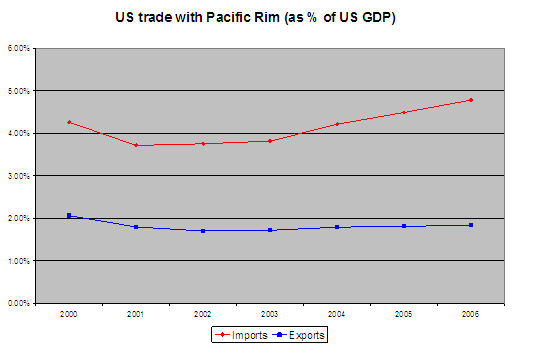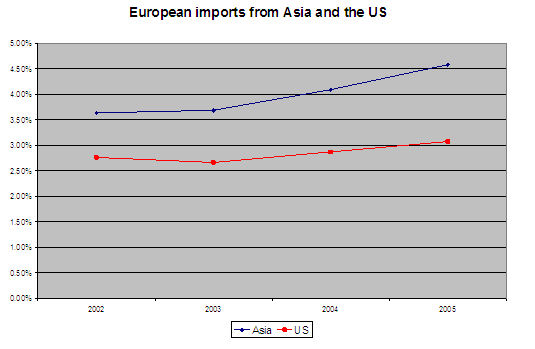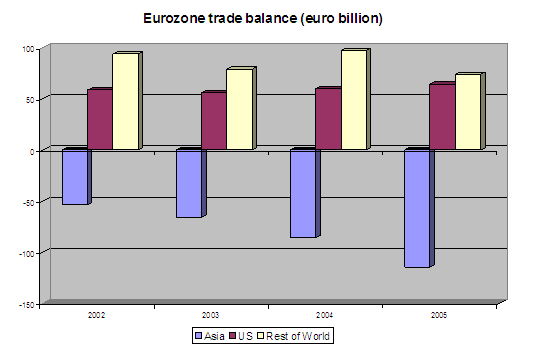So, Is China just taking market share from other countries in Asia?
In a word, no.
The argument that Chinese export growth just represents an shift in the location of final assembly from Taiwan, Korea and Hong Kong to China is extremely pervasive. I hear it frequently, including from some very smart people.
It is also false. Or at least dated. It is a bit like the argument that China doesn't have a current account surplus even though it has a bilateral trade surplus with the US. Both arguments worked in 2003. But neither argument works in 2005 -- when China's current account surplus reached 7.2% of its GDP ($161b), and overall imports from Asia soared in both the US and Europe.
Let me see if I can convince you.
The argument that China's export boom just represents a shift in the location of final production and assembly is built on something real. Electronics assembly did shift to China, largely from other Asian economies.
And from say 2000 to 2003, total US imports from the Pacific Rim were flat in nominal terms (and falling as a share of GDP). That stemmed as much from the tech bust as from anything else. But it certainly coincided with a shift in final assembly toward China.
But the world has changed since 2003. US import growth accelerated. The dollar tumbled. And China's exports to Europe boomed. And in both the US and in Europe, overall imports from Asia are rising as a share of GDP.
I already have posted the following chart showing US exports to and imports from the "Pacific Rim" as a share of US GDP. 2006 is obviously a forecast, but given the q1 data from China, I don't think it is much of a stretch. I used the 2005 rates of the growth for both imports and exports.

The overall US trade balance with the Pacific Rim has also deteriorated significantly after 2003.

I did a similar chart for the eurozone. Rather than showing imports and exports, though, it shows imports from Asia and imports from the US as a share of Eurozone GDP from 2002 through 2005. The data comes from the ECB.

Dollar depreciation had an impact - but it had a bigger impact on Asian dollar block exports than on US exports. That is the point of my previous post ...
This shows up clearly if you plot the overall change in the eurozone's trade balance between 2002 and 2005, broken down between the US, Asia and everyone else. Everyone else includes the oil exporters. And surprisingly, the deterioration in Europe's trade balance doesn't come with them. It comes from Asia. Rising imports have not been offset by rising exports.

I don't want to single out Asia.
The Gulf plays a big role in global imbalances too.
But exchange rates do matter. Asia largely sat out the 2002-2004 bout of dollar weakness. That had consequences.
Overall imports from Asia are rising as a share of both European and US GDP - and that increase has not been offset by rising European and American exports to Asia, so Asia's surplus with other industrialized (or least wealthy) parts of the world has grown. Asia pays a lot more for its commodity imports that it once did. But because of its rising surpluses with Europe and the US, it still runs an overall surplus as well. That too has consequences.
In 2005, Asia's aggregate current account surplus didn't fall even as the oil exporter's surplus expanded dramatically. That probably was the case in the first quarter as well, judging from China's strong export performance. Unless this pattern changes, the global current account only balances if Europe swings into a big deficit -- or the US deficit gets even bigger. I don't see as much evidence that the tide has turned as Dr. Roach. At least not yet. The "rebalancing" glass still seems half empty to me.
 Online Store
Online Store